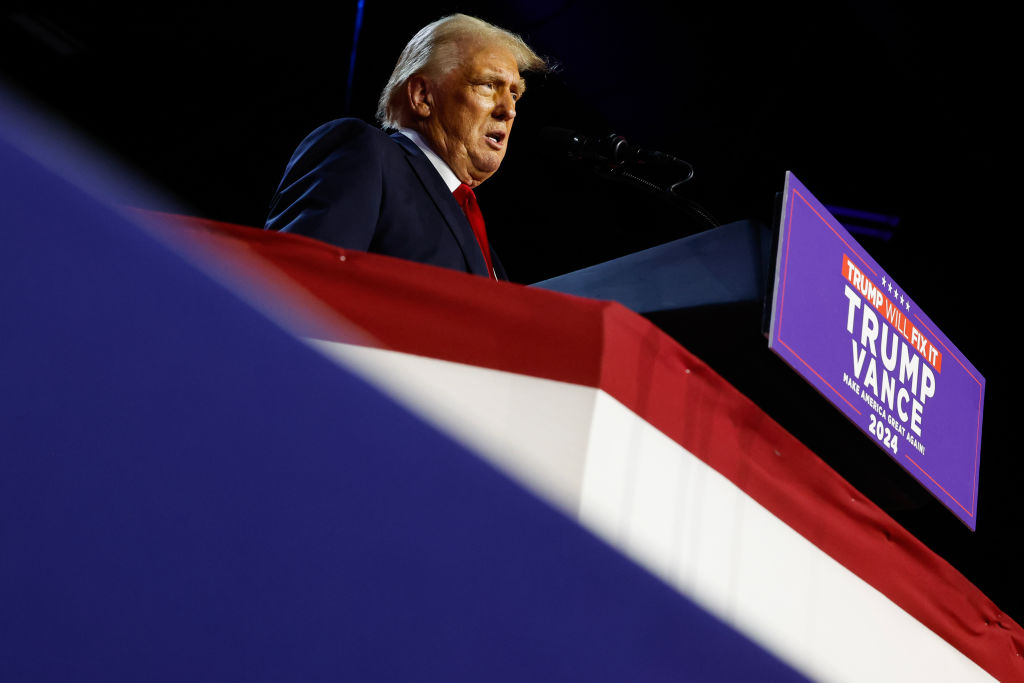President Trump’s tariff bombshell is more than simply a historic economic decision with geopolitical consequences on the side, as second-order effects. “Liberation Day” is best understood, first and foremost, as the fullest and cleanest expression of a certain geopolitical vision, with trade and economics only in a supporting role as instruments for realising it in practice. Trump is not just out to fix trade imbalances or re-industrialise the US: he wants to reshape the world and America’s place in it.
The approach seems to be that of taking a completely fresh look at America’s existing international alliance commitments and relationships – military, diplomatic and economic – and reviewing these “entanglements” from first principles to see what still makes sense from an America First point of view. This is a de facto reset of the geopolitical board, where the pre-Trump status of being a “friend and ally of the US” carries little weight with the current president, especially on tariffs. Such an approach is shocking to allied sensibilities, but only because most of our political and policy elites still cling to a world that is rapidly disappearing.
Geopolitical retrenchment
In many ways what Trump appears to be doing is to revert to George Washington’s “isolationist” prescription (in today’s terms) for the American Republic’s engagement with the world. In his 1796 Farewell Address, the first US president cautioned against “entangling alliances”. The Monroe Doctrine of 1823 built upon this foundation, proclaiming the Western Hemisphere a sphere of American influence to deter European intervention. Prior to World War I, US policy remained regionally focused, with interventions in the Philippines, Cuba and Panama, while avoiding European entanglements. The interwar period (1919–1939) saw a reinforced isolationism: rejecting the League of Nations, the US prioritized hemispheric oversight until the Japanese attack on Pearl Harbor in 1941 compelled broader engagement.
Now, in a similar way to these precedents – which, at the scale of history, are technically the normal mode of US foreign policy – the current president seems to be pursuing a form of geopolitical retrenchment. The new tariffs are self-evidently a move in this direction, given that their main effect is likely to be an inward economic turn and a further reduction of US trade with the world for a country whose trade income as a percentage of GDP is already the lowest among major economies.
If the geoeconomic picture is beginning to clarify on “isolationist” terms as a result of Liberation Day, we have only seen half of the geopolitical one – i.e., Trump’s intention to extricate the United States from Europe and its troubles, especially the Ukrainian war. The other “big half” is the Indo-Pacific, which is nominally the primary area of strategic US concern and the region where America’s key rival, China, is growing in strength and testing regional alliances.
Indeed, a potential war with China – over Taiwan – is the US military’s main strategic assumption. The notion that the US is engaged in a strategic competition with China, and that China is the key adversary whose power must be curbed and whose influence must be contained, is now gospel in Washington DC, and one of the few issues with bipartisan support. Trump himself was chiefly responsible, in his first term, for shifting US policy towards a more aggressive stance on China and for unifying the US political class behind confronting Beijing.
And yet, it is hard to ignore the increasingly obvious logical inconsistency between Trump’s overall “restrictionist” – if not isolationist – instincts as seen in Europe and with the tariffs, and the idea or expectation that he actually wants to contain China in military terms in the Indo-Pacific. This kind of concern is usually dismissed by pointing out that the pivot away from Europe would be precisely in order to reinforce America’s Indo-Pacific posture.
But is that actually true, or is it merely an assumption about what Trump actually has in mind with respect to China in grand strategic terms? Is the drawdown in Europe a rebalancing of US efforts towards China, or is it merely the first half of a general US strategic retrenchment in its Western Hemisphere – as discussed in these pages before – with US posture in the Indo-Pacific to follow?
Fighting China economically and fighting it militarily are two different things. President Trump is certainly up for the former, but it is unclear if he is prepared to do the latter without a compelling strategic justification. Why exactly, he and some of his team might ask, why exactly does the US really need to risk a war with China in order to “defend” Taiwan? Past commitments and agreements surely do not factor into this, as they do not seem to with respect to US European policy and NATO.
The answer comes in different flavours depending who one asks. But generally it has to do with maintaining US dominance in the region and supporting US allies, while preventing a Chinese “strategic breakout” beyond the First Island Chain which would then cripple US influence and expand that of China. Confronting China is also a matter of moral principle for many China hawks, on account of the Chinese Communist Party’s record on human rights and its totalitarian ideology.
But Trump does not seem to care much about nebulous concepts of US “influence” – otherwise his policy on Europe and Russia, for example, as well as on tariffs, would have been very different. Nor is he, as a self-described pragmatist and deal-maker, much concerned with grounding policy decisions in moral analysis of adversaries. It is therefore high time that the case for US extended deterrence in the Western Pacific was investigated anew from from more provocative angles.
The economic stakes over Taiwan
The Indo-Pacific generates 60 per cent of global GDP and drives two-thirds of economic growth. This is why it is usually held that the US security presence in the Indo-Pacific is not mere posturing but a backbone for economic prosperity. US trade with the region reached $2 trillion in 2022, accounting for roughly 33 per cent of America’s $6.1 trillion total trade, and supports an estimated 3-4 million jobs. US naval dominance ensures open sea lanes, such as the Taiwan Strait, through which over $1 trillion in goods flows annually. This stability benefits American firms like Walmart and Apple, keeping shipping costs low and reliable.
US alliances with Japan and South Korea secure $145 billion in annual exports ($80 billion to Japan, $65 billion to South Korea in 2024), United States benefits from $956 billion in foreign direct investment from the Indo-Pacific. Taiwan’s semiconductor industry, producing 60 per cent of the world’s semiconductors overall and 90 per cent of the most advanced ones (in the sub-10 nanometre category), is – for now – essential for US tech, from consumer goods to defence systems.
If China seized Taiwan without a fight, the trade fallout would be significant (in case of a US-China war over Taiwan, the consequences are incalculable). Trade with Taiwan itself is worth almost $160 billion (around $40 billion in exports). Regarding semiconductors, a shortage, through the loss of Taiwanese chipmaker TMSC, could translate into as much as an 8 per cent hit to US economy overall – until domestic production ramps up. But the impact on specifically US exports to the Indo-Pacific would be much more limited, as only a minority share of US goods sent there are dependent on chips. Regional US trade might also decline; Japan and South Korea could trim US imports by 5-10 per cent ($7-15 billion) over the following years if Chinese influence grows, though none of this is automatic.
As a very rough estimate, total US (bilateral) trade losses in the region might reach $200-400 billion, excluding trade with China which, if there is no war, could well continue. This is equivalent to roughly 2-3 per cent to 6 per cent of US global trade overall – meaningful but not catastrophic.
Furthermore, Indo-Pacific sceptics might argue, China is unlikely to block shipping routes outright – its $3.5 trillion export economy depends on them too, and it’s not clear what reason it would have to curtail maritime traffic. Regarding semiconductors, Biden’s CHIPS Act ($52 billion to boost US chipmaking) is designed precisely as an insurance policy against the TMSC exposure and will ease US tech vulnerabilities by 2030, aiming for 20 per cent of global advanced chip supply.
Similarly, it is not immediately clear why South Korea and Japan would reduce their imports of US goods post-Taiwan, in the absence of some form of direct coercion by China, especially if US troops remain stationed in both countries. A US military pull-out from northwest Asia, meanwhile, could destabilise trade as Seoul and Tokyo might feel “betrayed”. But it might also play into a new geopolitical and geoeconomic order in the region where the US would compete economically just like any other nation, without the “extra” advantage of political influence as in the post-1945 era.
The real danger of giving Taiwan up, of course, is not instant economic ruin for the United States – the shock could be absorbed – but a slow strategic bleed. A Taiwan loss certainly hands China leverage in the Indo-Pacific: control over chips, trade terms, and regional sway. US firms might face coercion – e.g. being asked to share tech or lose markets – while allies (or erstwhile allies) could choose to hedge, drifting toward Beijing’s orbit over a decade or so. All in all, this could shave 1-2 per cent off US GDP growth long-term ($400-800 billion annually by 2040) and weaken the dollar’s current 60 per cent reserve status, hiking borrowing costs by $100-200 billion yearly.
Again, none of this is assured. Instead of giving in to Chinese influence post-Taiwan, regional countries from Japan and South Korea to Australia might in fact double down on their resistance to China and cause increased troubles for Beijing. Besides, China’s ascent is not unstoppable. Its population dropped 1.39 million in 2024 for the third year in a row, with a fertility rate of 1.0, and by 2035, 450 million will be over 60, straining its workforce and welfare systems. Local government debt is $8.3 trillion, growth is still below pre-pandemic levels, and FDI plummeted 80 per cent in 2023 to $33 billion as Xi Jinping’s authoritarian grip unnerves investors – even if now the Europeans appear keen to cosy up to Beijing once more, in view of Trump’s tariffs.
China’s expanding influence has already invited resistance: India is bolstering its military, Japan is rearming, and ASEAN nations resent South China Sea claims. Taking Taiwan might win a tactical victory but ignite a strategic backlash, straining China’s brittle economy and governance – potentially to breaking point.
A retreat from the Indo-Pacific?
Could a US retreat to the Western Hemisphere – not just from Europe, but from Asia too – turn weakness into strength? The case for it might be quite compelling to someone like Trump who is already clear on his priorities: fixing America at home, disentangling the country from costly foreign commitments, making peace, avoiding war. The idea of really fighting China over Taiwan cuts against all of that, for no clear benefit from a Trumpian perspective. Indeed, it is a pivot away from Taiwan and the Indo-Pacific, and a shift to a hemispheric strategy, which would be consistent with the thrust of US foreign policy under the current Administration.
After all, the United States rose to economic pre-eminence in conditions of geopolitical “isolation”, almost a century before the post-Cold War “globalisation”. Even today, it trades mostly with itself, while in terms of international trade that with Canada and Mexico stands at some $1.7 trillion, more than with any other single region.
Trump may well judge that cutting the approximately $30 billion in annual Indo-Pacific military costs (basing, operations etc) could fund infrastructure at home ($2.6 trillion deficit) or dent the $36 trillion national debt. America’s advantages – oil production (13 million barrels/day), arable land, and a median age of 38 – contrast with China’s problems. As the CCP’s global dominance grows – censoring, surveilling, strong-arming – a freer US could draw firms and FDI ($5 trillion stock vs. China’s $3.6 trillion).
This is essentially nothing more than the classic argument for the cycle of empires, where over-extension begets increased costs, internal dissent and general decay over the longer term. It may also be the argument – or instinct – that is pushing Trump to wind down America’s de facto world-imperial posture, in ways not dissimilar to the end of Empire in the case of Britain.
The grandest of bets
Whether Trump really has in mind a pullback from the Indo-Pacific as well, with the loss of Taiwan, only time will tell. He will know that such a “project” must be handled with some more care than he seems to be applying to other issues. Any strategic pivot from the Indo-Pacific will have to be accompanied by some “deal” with China; and in Trump’s often-inverted logic, opening the road to such negotiations by unleashing a brutal trade war – as we are seeing now – is exactly what we should be expecting.
Yet, no matter how one looks at it, any retreat carries trade-offs. Losing Indo-Pacific influence risks tech lag – Taiwan’s chips will not shift to or be replicated within the US quickly. Allies might not wait – they could accelerate their military buildup – some also acquiring nuclear weapons perhaps – or drift, making the world less predictable. A hemispheric-focused US might thrive short-term – leaner, less entangled – but by 2040, the strategic risk is that it could be a regional power, not a global one, in a system shaped by China’s rules.
On the other hand, a Taiwan loss would not be the endgame – even roughly $400 billion in trade losses, at worst, and a decade of drift will not sink the US economy. China’s own burdens – demographics, debt, dissent – might hobble its rise. A US retrenchment in its own hemisphere, to focus on itself for a while, could forge a more competitive America, especially if Beijing overreaches. But the risks are real: not collapse, but erosion.
The Indo-Pacific matters not because it is “vital” to America’s destiny but because losing it could start a clock – one where the US could adapt and rebound, or watch China, despite all of its own problems and flaws, define the future. It is likely that Trump himself is not yet decided on Indo-Pacific policy. But if there is anything to make him stay the course on the Taiwan issue it will be US domestic politics rather than his own instincts.






Congress and the ‘Trump supremacy’